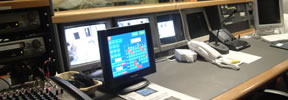Find a Course
Search for a subject or speciality to find courses relevant to you. Most of the courses that MCSC provides are free of charge to NHS staff in the Yorkshire and the Humber Region.
Simulation is a person, device, or set of conditions which attempts to replicate real-life to enable the assessment and evaluation of problems authentically.
A high fidelity Human Patient Simulator (HPS) is a whole body manikin with driving mechanical and computer software. This type of simulator has sophisticated modelling of the cardiovascular and respiratory systems of a human. Fluid status, acid-base and temperature are also modelled along with the pharmacodynamic effects of a number of intravenous drugs. Such systems improve upon desktop simulators by presenting information in a realistic form rather than at a computer screen interface.
The whole body manikin can be instrumented and has a full monitoring interface. The simulator can be programmed to represent different types of patient, the young and fit or the old and frail. When a drug is administered to the manikin it is recognised by the system and the appropriate pharmacodynamic response seen for the chosen physiological patient. Thus a small dose of adrenaline in a young and fit patient may simply cause tachycardia and hypertension. In the frail patient, modelled to have ischaemic heart disease, such changes may be exaggerated and accompanied by dysrhythmias or ischaemic changes. The manikin can talk, by virtue of an actor speaking into a microphone from the control room.
Anyone working in the acute specialties will have concern about their ability to perform will in a difficult or life threatening situation. Teams responding to cardiac arrest or trauma calls can funtion efficiently or poorly together depending on a number of factors - knowledge, experience, team interaction,communication and leadership to name but a few. These issues can be explored safely in a realistic environment in the Centre, such as on a ward, in A&E, or in an operating theatre or surgery. The simulator allows teams to rehearse events that are rarely seen in everyday practice. Incidents such as anaphylaxis can occur with alarming rapidity anywhere and at any time. Ours courses focus no mechanisms that help recognise and verify the provisional diagnosis as well as teaching the elements within the treatment protocol itself. Obviously, medical error is an important issue within the health service and through simulation different clinical personnel can be taught about awareness and avoidance of error prone situations. The simulator is also used to clarify difficult concepts and help bring principles learned in the classroom to life, enabling delegates to put theory into practice as they go through the structured educational goals.
As in any high risk team based industry, good communication plays a key part of team working and avoiding errors. Simple components such as clear verbal communication, not raising ones voice and avoiding making statements into thin air can make a big difference to team communication. Fostering an atmosphere of open exchange including concentrating on what is right, not who is right, can help avoid many crises. Such simple advise is surprisingly rarely practised. Through simulated scenarios and debrieinfg afterwards, the participants can evaluate their own and the teams communication.
Search for a subject or speciality to find courses relevant to you. Most of the courses that MCSC provides are free of charge to NHS staff in the Yorkshire and the Humber Region.

Catering – the restaurant opens at 9 am serving hot & cold meals. WRVS kiosk has fresh sandwiches & snacks.
NB There is *NO ATM* on the hospital site.
Learn about our facilitiesCongratulations to Sue Claypole, Sharon Lukins, Maya Naravi and Alastair C Graham
Nicola Mann is leaving MCSC for pastures new